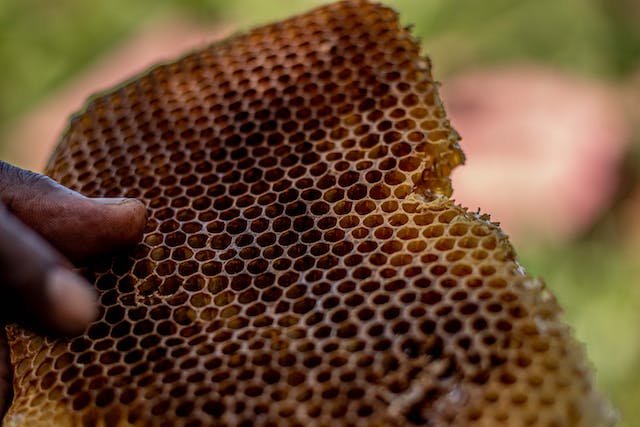Physical Address
304 North Cardinal St.
Dorchester Center, MA 02124
Physical Address
304 North Cardinal St.
Dorchester Center, MA 02124

A beehive is like a house for bees, made up of honeycombs. These honeycombs are six-sided shapes where bees store honey. But guess what? Honeycomb isn’t just for bees, people can eat it too! It’s yummy and has a sweet, chewy taste.
Imagine this: honeycomb is like a natural candy made by bees. When you take a bite, it’s like having a little treat from nature. Not only does it taste good, but it’s also interesting to learn about.
Let’s dive deeper! Honeycomb isn’t just tasty; it’s also useful for us. People enjoy eating it as a snack or using it in recipes to add natural sweetness. Plus, it’s kind of neat to see how bees make something that we can enjoy too!
So, in this article, we’ll explore more about what honeycomb is made of, how bees create it, and the different ways people like to eat it. Whether you’re curious about trying something new or just love sweet treats, learning about honeycomb is pretty cool!

A honeycomb is a pattern made up of six-sided cells that bees build. It’s like tiny compartments where bees store honey, pollen, propolis, royal jelly, and even baby bees called larvae. Bees make this structure using beeswax, which they produce from special glands. People can eat honeycomb, and you can buy it at farmers’ markets or straight from beekeepers.
Each cell in the honeycomb has a specific job. Bees store their food like honey and pollen in some cells, while they use other cells to nurture their young bees. The hexagonal shape of the honeycomb cells is efficient and saves space. It’s a bit like a puzzle where each piece fits perfectly together.
Honeycomb is not just tasty but also has health benefits. Some people eat it for its natural sweetness and nutrients. It’s used in recipes, like adding it to cheese platters or spreading it on toast.
When you buy honeycomb, you’re getting a piece of the beehive! And by buying from beekeepers or local markets, you’re supporting beekeeping and helping the environment because bees are essential for pollinating plants and crops.
Honeycomb is a delicious natural treat made of sweet honey and chewy beeswax. When you eat honeycomb, you’re savouring the raw honey’s sweetness and the wax’s chewiness, much like chewing gum.
To relish this delightful snack, you can enjoy small pieces of honeycomb on their own. Additionally, it can be a perfect addition to a variety of foods. Try incorporating honeycomb into your diet by adding it to a fruity smoothie for extra sweetness or including it in a salad or a charcuterie board for a unique flavour. Pairing honeycomb with Brie cheese brings out its delicious taste even more.
For a delightful twist, consider topping warm bread, English muffins, waffles, or a scoop of vanilla ice cream with honeycomb. The combination of textures and flavours will elevate these dishes, creating a memorable culinary experience. Whether enjoyed by itself or added to different dishes, honeycomb is a versatile and tasty ingredient that can enhance your meals and snacks in various delightful ways.
Eating raw honeycomb might not offer many nutrients, but liquid honey derived from it possesses antioxidants and anti-inflammatory traits. Honey, a natural cough reliever, has been known to ease allergies and persistent coughs. The unfiltered nature of raw honey preserves enzymes from bees, granting it antimicrobial and antibacterial abilities.
However, alongside these benefits, raw honey can harbour potential risks. It might contain byproducts like botulism spores, posing threats to young children and individuals with weakened immune systems or expectant mothers. Additionally, those allergic to bee venom or pollen should abstain from consuming honeycomb due to possible adverse reactions.
Despite the enticing properties of honey, especially in its raw form, it’s crucial to weigh its advantages against the associated risks, particularly for vulnerable populations. The antimicrobial benefits should be balanced against the potential dangers, ensuring informed consumption choices.